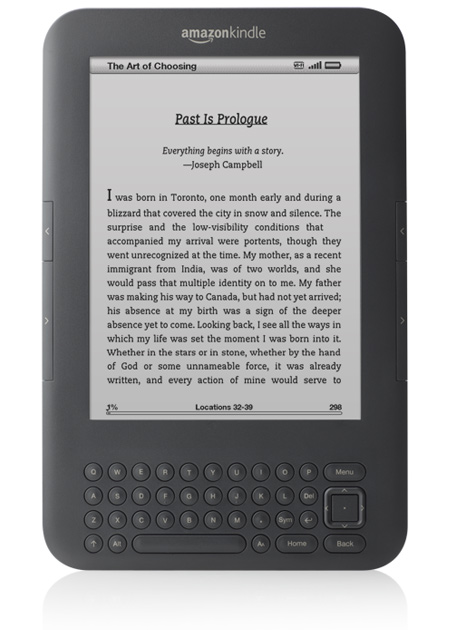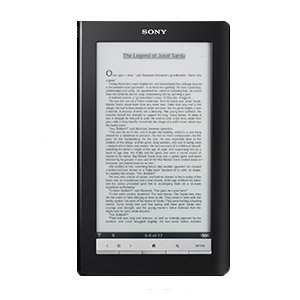The E-Book Revolution
By Wayne Maruna
 Many of
you know Bob and Arlene Costanzo. Bob is a former HOA president who can
frequently be found sunning himself on one of Taberna’s
fairways. Arlene is active in the Taberna garden club and has been an avid book
reader and participant in book clubs for years. And so Arlene was thrilled when
Bob announced last December that he had purchased a Kindle, Amazon’s electronic
book reading device – at least up to the moment when he said he bought it for
himself, not for her.
Many of
you know Bob and Arlene Costanzo. Bob is a former HOA president who can
frequently be found sunning himself on one of Taberna’s
fairways. Arlene is active in the Taberna garden club and has been an avid book
reader and participant in book clubs for years. And so Arlene was thrilled when
Bob announced last December that he had purchased a Kindle, Amazon’s electronic
book reading device – at least up to the moment when he said he bought it for
himself, not for her.
“But you very seldom read books!” Arlene protested, still eyeing the Kindle box with anticipation.
“Well I plan to start” Bob said.
Needless to say, the Costanzo household now owns a matching pair of Kindles.
Bob and Arlene are not alone. E-readers of many flavors were favorite Christmas purchases this past year, be they Amazon Kindles, Barnes & Noble Nooks, Sony Readers, or one of the growing stable of tablet devices.
Late last year, Forrester Research published their projection that the number of people using e-readers would triple by 2015, from 17.6 million to 60 million, and e-book spending would follow suit. They may want to revisit their figures. According to statistics compiled by the Association of American Publishers (AAP), e-book sales tripled in Feb. 2011 as compared to Feb. 2010. E-books ranked as the number one format among all categories monitored by the AAP. Year-to-date e-book sales are up 169% while by contrast all categories of print books combined declined by 25%.
Whenever new technologies impact an industry this quickly, especially an industry as established as book publishing, the effects can be far ranging. I got to wondering what this might mean to as venerable an institution as the public library. To try and get some background, I sent an email to one of the members of the New Bern Computer User Group, Victor T. Jones, who is the Special Collections Librarian for the New Bern – Craven County Public Library. As one might expect from a professional librarian, I received some excellent guidance and direction for further research on the subject, and have borrowed freely from the content of his responding email in composing this article.
According to Mr. Jones, E-media is all the library trade magazines (e.g. Library Journal) are discussing lately. His linked articles made clear that both the publishing industry and the representatives of our public libraries are struggling to come to grips with what to do in the face of this fundamental change and how it will affect their futures. The publishers desire to treat e-books as if they were still printed on paper, while at the same time enforcing Digital Rights Management (DRM) policies that are seen by many as unfair and restrictive.
Those public libraries able to start building an e-book collection have done so with the agreement from publishers that once a library buys an e-book, it can lend it out, one reader at a time, an unlimited number of times. But recently one publisher, HarperCollins Publishers, began enforcing new restrictions limiting to 26 the number of times an e-book could be checked out, after which the license would expire. The library would then be required to repurchase the e-book, though the expectation would be at a reduced rate, somewhat analogous to purchasing a paperback version of a book previously available only in hard-bound. Many libraries have responded by refusing to purchase e-books from HarperCollins, since most library budgets are stagnant at best. NPR’s “All Things Considered” even did a piece on the subject which the American Library Association discussed in the article which can be found at http://tinyurl.com/657hoe9.
Many libraries
across the nation currently loan e-books via download, and some even loan out
e-readers preloaded with titles. The e-books are typically available to one
user at a time for a defined period of time. No trips to the library are
required. E-books can be downloaded at home, and after the designated checkout
period, the e-book automatically expires from the borrower’s account.
Interestingly, library e-books cannot currently be read on Amazon’s Kindle,
though it’s thumbs-up for the Barnes & Noble and Sony products.
 The New Bern – Craven
Country public library fields several calls a week asking about the availability
of e-books. Unfortunately, funding levels do not permit adding them at this
time. But just as the library over time eventually added books on tape, then
books on CDs, and later DVDs, the time will come. Currently some titles are
available through a service called NetLibrary and some through other vendors on
NC-Live, though these can only be viewed on a computer and not downloaded to a
dedicated e-book reader. Check out
http://www.nclive.org/ or contact the library (252-638-7800) for further
information.
The New Bern – Craven
Country public library fields several calls a week asking about the availability
of e-books. Unfortunately, funding levels do not permit adding them at this
time. But just as the library over time eventually added books on tape, then
books on CDs, and later DVDs, the time will come. Currently some titles are
available through a service called NetLibrary and some through other vendors on
NC-Live, though these can only be viewed on a computer and not downloaded to a
dedicated e-book reader. Check out
http://www.nclive.org/ or contact the library (252-638-7800) for further
information.
The Library Journal article found at http://tinyurl.com/2cxuom9 suggests that school librarians may find their “…budgets completely devoured by an e-book monster sooner than they imagine. We are only a few years away from e-book reader devices being cheap enough that it will be economically feasible to put an entire school library and all of a school's textbooks into every student's backpack.”
Well, maybe, or maybe not. In any case, it is likely that such industry participants as ink producers, paper manufacturers, glue makers, and even tree loggers are already feeling an impact.
Most insiders don’t expect the HarperCollins 26-loan limit to stick, but rather to start a discussion amongst key parties to arrive at a workable and equitable solution. This much is clear: it’s going to get a bit bumpy in the usually tranquil halls of the nation’s libraries.
Anyone up for singing a chorus of Marian, Madame E-Librarian?